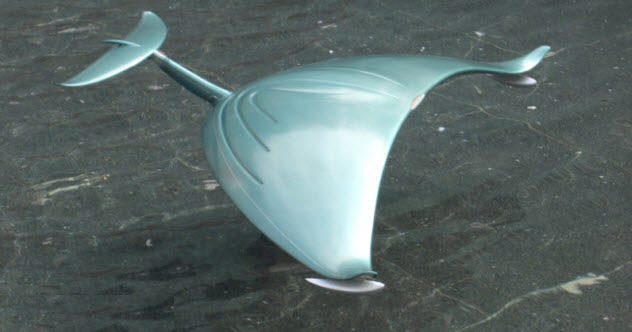 Mysteries
Mysteries  Mysteries
Mysteries  History
History 10 Surprising Stories About the Texas Rangers
 Humans
Humans 10 Philosophers Who Were Driven Mad by Their Own Theories
 Miscellaneous
Miscellaneous 10 Video-Game-Worthy Weapons and Armors from History
 Weird Stuff
Weird Stuff 10 Psychics Who Accurately Predicted Wartime Events
 The Arts
The Arts 10 Pieces of Art Inspired by a Broken Heart
 Health
Health 10 Science Fiction-Sounding New Medical Treatments
 History
History 10 Surprising Facts About the Father of Submarine Warfare
 Space
Space Ten Astonishing New Insights into Alien Worlds
 Weird Stuff
Weird Stuff 10 Bizarre Summer Solstice Rituals Still Practiced Today
 Mysteries
Mysteries Top 10 Haunting Facts About the Ghost Ship MV Alta
 History
History 10 Surprising Stories About the Texas Rangers
 Humans
Humans 10 Philosophers Who Were Driven Mad by Their Own Theories
Who's Behind Listverse?

Jamie Frater
Head Editor
Jamie founded Listverse due to an insatiable desire to share fascinating, obscure, and bizarre facts. He has been a guest speaker on numerous national radio and television stations and is a five time published author.
More About Us Miscellaneous
Miscellaneous 10 Video-Game-Worthy Weapons and Armors from History
 Weird Stuff
Weird Stuff 10 Psychics Who Accurately Predicted Wartime Events
 The Arts
The Arts 10 Pieces of Art Inspired by a Broken Heart
 Health
Health 10 Science Fiction-Sounding New Medical Treatments
 History
History 10 Surprising Facts About the Father of Submarine Warfare
 Space
Space Ten Astonishing New Insights into Alien Worlds
 Weird Stuff
Weird Stuff 10 Bizarre Summer Solstice Rituals Still Practiced Today
10 Proposed Airliners Of The Future
Air travel is a common occurrence in our modern society. When most people imagine commercial airliners, they imagine the standard tube-and-wing configuration. However, aerospace engineers across the world are developing concepts for future airliners that would revolutionize air travel.
10 Aether Airship
Airships were a big part of commercial aviation before they slowly died off in the mid-20th century. However, some intrepid aerospace designers are now developing designs to bring airships back into use.
One of the more interesting ideas is the Aether airship. Designer Mac Byers realized that his airship needed to look different than old airships so that people did not associate it with disasters like the Hindenburg explosion. Thus, the Aether airship has a long, sharklike appearance that communicates both safety and futurism.
This airship is more like a cruise ship than a normal airliner. Conceptually, the Aether airship would travel to different locations while offering enough amenities so that passengers wouldn’t need to leave the airship if they didn’t want to.
Passengers would have access to a large variety of dining options and comfortable rooms to stay in. Byers’s design takes advantage of the scenic sky with large windows for the passengers.
Although the design is only a concept, it offers a glimpse into the future. Other companies are also investigating airship concepts. They are more economical, have a large payload capacity, and offer an entirely new travel experience for modern tourists. Within a few years, airships could make a return.
9 Boeing Blended-Wing Airliners
Although Boeing recently started production of its 787 airliner, its engineers are already working on their next airliner. This time, Boeing is planning to do something radically different from its standard designs.
Instead of the same fuselage-and-wing design, Boeing engineers are looking at creating a blended-wing airliner. In blended-wing designs, the wings and fuselage flow into each other, removing the distinction between the two parts.
Both NASA and Boeing are currently experimenting with blended wings for both commercial and military purposes. To explore the aerodynamic possibilities, the two groups worked together to build the X-48, an unmanned jet airplane built with a blended-wing design.
The X-48 tests were successful, showing that the airplane had a high payload, was quieter than expected, and had extremely good fuel efficiency. Based on this, it is obvious that blended-wing bodies are the future of aerospace.
NASA is considering civilian applications of the concept, hoping to develop prototypes for airliners within 20 years. On the other hand, Boeing is looking at military applications for the design, mostly for airlift and aerial refueling purposes.
Lockheed Martin is also looking into a future airlift design using blended-wing technology. The company hopes to design an airplane with a huge payload.
Since these companies are investing in blended-wing bodies, it is extremely likely that the next generation of airliners will use the concepts pioneered by the X-48.
8 Reaction Engines A2
Another big push in aerospace is hypersonic airliners. While the Concorde and the TU-144 made history as the first commercially operated supersonic airliners, modern engineers are now looking to design airliners that are capable of speeds in excess of Mach 5.
On the cutting edge is UK company Reaction Engines Limited, which designed a concept for an airliner called the A2. This futuristic-looking airplane would travel at hypersonic speeds and be environmentally friendly.
The A2 uses the Scimitar engine, another design from Reaction Engines. The Scimitar uses technology that is derived from the SABRE engine. Both engines are hybrid engines. But while the SABRE uses rocket engines, the Scimitar uses a hybrid ramjet and normal air-breathing jet engine design.
When the Scimitar is flying at high speed, it uses the ramjet. But during takeoff and landing, it engages a high bypass mode that operates like a normal jet engine. The Scimitar uses liquid hydrogen for fuel, which also cools the engine right before ignition. This type of engine is known as a pre-cooled engine and is used for long-range endurance at hypersonic speeds.
Due to concerns over sonic boom noise, the A2 would only fly hypersonically over the ocean or unpopulated areas. When flying over populated regions, it would fly just under the speed of sound.
At top speed, the A2 can fly from Australia to northern Europe in just five hours. One big concern with the A2 is passenger comfort. Due to concerns over stress on the airframe, the A2 does not have windows. Claustrophobic customers might find the flight uncomfortable.
7 Bombardier Antipode
Not content to let the UK take the lead with hypersonic aerospace designs, Canadian company Bombardier recently got in the game with the Antipode, their concept business jet. They designed a small airplane that only carries a few people but can fly at Mach 24. At that speed, the Antipode can travel from New York to London in 11 minutes.
The Antipode concept makes use of a scramjet engine, a rather straightforward improvement on the normal ramjet engine. Scramjets have no moving parts such as fans or compressors. Instead, they rely on the speed of the airplane to force air through the engine.
As the scramjet travels at high Mach numbers, hypersonic air enters the engine and slows down to supersonic speeds. Then more hypersonic air enters the engine after the slowed air, forcing it through the engine and producing thrust with combustion.
To get to the speeds required for the scramjet to work, the Antipode would use rocket boosters to launch off the ground. Once the airplane gets to cruising altitude and speed, the scramjet would kick in, accelerating the vehicle to Mach 24.
However, a big concern is that the body of the airplane would get too hot at those speeds from air friction. Bombardier proposes a solution called long penetration mode. The system uses vents in the nose of the airplane to blow chilled supersonic air over the fuselage, cooling it while also reducing the sonic boom noise.
Whether the Antipode will ever be put into service is up for debate, but the concepts designed for it may be used in the next generation of airliners.
6 Boeing Pelican
In the early 2000s, Boeing investigated the construction of a new transoceanic airplane called the Pelican. Although designed primarily to carry cargo, the ideas behind the Pelican are applicable for commercial airliners. In concept, the Pelican was a huge airplane which used the ground effect to fly.
The ground effect is an aerodynamic phenomenon in which low-flying objects with specially shaped wings can trap air beneath them and use the cushion to glide quickly and efficiently across water. The Pelican would take advantage of the ground effect over the ocean, flying only 6 meters (20 ft) above the water.
During overland flight, the Pelican would fly at normal altitudes. By using the ground effect, Boeing hoped that the Pelican would be extremely fuel efficient, which was important for the gigantic airplane. With a wingspan of 150 kilometers (500 ft), the Pelican would be the largest airplane in the world.
Although the design was promising, Boeing has not revisited the concept since the early 2000s for unknown reasons. However, the concept of a ground-effect transport will likely reappear in civilian aviation because it can carry loads comparable to ships at higher speeds with minimal fuel cost.
5 SAX-40

Even when airplanes are traveling as subsonic speeds, their engine noise is annoying to people living around airports and can cause adverse health effects for people working around airplanes. To combat the problem, a group from MIT and Cambridge University developed the SAX-40, a super-quiet airplane concept.
Airplanes are noisy mainly because of irregularities in their bodies, so the SAX-40 is highly streamlined. Due to its body shape, the SAX-40 has far more lift than a normal airplane. As a result, it would not need to use flaps to get enough lift during takeoff and landing, reducing the noisiness of the engines.
The engine intakes are on top of the airplane, letting the fuselage shield people on the ground from engine noise. To cut the noise of the engine exhaust, the SAX-40 uses variable exhausts that would change shape during flight for minimal noise.
These are the major design features of the SAX-40. With its lifting body design and special wings, the airplane would only generate 63 decibels of noise on takeoff and landing outside the airport perimeter. For comparison, normal jets take off at 100 decibels. The SAX-40 would generate as much noise as an air-conditioning unit.
4 SpaceLiner
The German Aerospace Center (GAC) is currently developing its own design for high-speed travel. However, instead of just relying on standard airplane ideas, the GAC is developing a spaceplane called the SpaceLiner.
In concept, the SpaceLiner combines the best characteristics of a rocket and an airplane. Like the US space shuttle, the SpaceLiner uses a two-stage concept. The spaceplane rides up to high orbit on a cryogenic rocket booster, which then drops away.
To make the concept reusable, the Germans are developing special planes to capture the falling booster in midair. At extremely high altitudes, the SpaceLiner accelerates to Mach 25, which would enable it to fly from Australia to Europe in under 90 minutes.
At the end of the trip, the spaceplane lands like any normal airplane. The project has many advantages, including speed and reusability. But the SpaceLiner is also environmentally friendly. Since it uses liquid hydrogen and liquid oxygen as rocket propellant, the only by-product of its engines is water vapor. The GAC hopes to see the SpaceLiner in operation by 2050.
3 AWWA-QG Progress Eagle
The AWWA-QG Progress Eagle is one of the most complex concept airplanes floating around. At first glance, it seems like somebody just combined every cool future technology into one airplane, but the Progress Eagle is a valid proposal for a large, environmentally friendly passenger airplane.
The Progress Eagle is huge, dwarfing every other airliner with its triple-deck design and 800-passenger payload. Due to its huge size, the Progress Eagle has folding wings so that current airports would not have to go through big renovations.
For power, the Progress Eagle uses six hydrogen-powered engines, which also provide electricity during the flight. However, most of the electricity would come from the solar panels in the wings. These panels use quantum dot material to boost efficiency.
The Progress Eagle would also sport a CO2 cleaner to actively clean the air through which it travels. Designer Oscar Vinals is optimistic that his airplane will enter service in 2030.
2 Concorde 2
Although the Concorde, the first supersonic airliner, was eventually retired, its legacy lives on with the next generation of proposed airliners. Last year, Airbus won patent rights for their design of a new airplane called the Concorde 2. Following in the original plane’s footsteps, this second version would push the boundaries of flight to become the first hypersonic airliner.
The key selling point of the new plane would be its Mach 4.5 cruising speed. But the plane has a variety of other strange features, most notably its propulsion system. The Concorde 2 would use three types of engines.
For takeoff, the plane would use lift jets for a vertical takeoff, similar to a Harrier jump jet. Once the Concorde 2 is in the air, a rocket engine would shoot the passenger jet to its altitude and supersonic speeds. Finally, ramjets on the wings would accelerate the plane to its Mach 4.5 cruising speed.
To cut down on sonic booms, the Concorde 2 has an odd-looking wing that also provides high lift. Although the Concorde 2 would be faster than the original plane, it also has a smaller passenger complement—only 20 people compared to original Concorde’s 120.
1 Mobula

The Mobula, designed by Chris Cooke from Coventry University, is one of the strangest new concepts for an airliner. This breathtaking design bridges the gap between airplanes and ocean liners. Capable of carrying over 1,000 passengers on five decks, the Mobula is about more than getting to the destination. It is also about the experience.
Like the Pelican, the Mobula is an ekranoplan. Flying just a few meters above the ocean, the Mobula can use the ground effect for lift and rapid travel. For water operations, the Mobula also has floating capabilities and can easily rest on the surface on the water.
After studying the shape of animals, Cooke designed the Mobula with its organic look. But the design is not meant for pure aesthetics. In wind tunnel tests, the Mobula proved ideal for low-altitude flying with minimal drag.
Although the Mobula will probably remain a concept vehicle, it gives a glimpse into the future of air travel. Large, fast-moving ekranoplans would change the way that people travel across the ocean. Even if the Mobula is never built, it could become an important precursor to a revolution in air travel.
Zachery Brasier writes.






